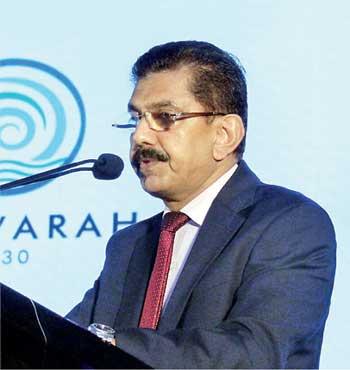14 Aug 2024 - {{hitsCtrl.values.hits}}
 |
| Dr. Anil Jasinghe Pic by Pradeep Dilrukshana |
By Nishel Fernando
As sustainability is no longer a choice but a necessity for the textile and apparel industry, a top public official stressed that large industry players have an inherent responsibility and a larger role to play in guiding and supporting the whole industry on the path to sustainability.
Presidential Secretariat, Climate Change Office Sri Lanka, Senior Additional Secretary/ CEO Dr. Anil Jasinghe highlighted the significant environmental impact of textile production, including water and energy consumption, waste generation, and carbon emissions. He emphasised that adopting sustainable practices is essential to conserving resources, reducing water usage, and minimising the industry’s carbon footprint.
Adopting sustainable practices is crucial to conserving resources, reducing water usage, and minimising the industry’s carbon footprint, he said.
Dr. Jasinghe acknowledged the efforts of the country’s major apparel players in advancing sustainability without substantial state support, contributing to their global competitiveness.
“The big players in the apparel industry have been trailblazers in greening their operations. However, it’s crucial that elder brothers support the younger ones,” he said, delivering the keynote address at Sri Lanka’s first-ever Sustainability Summit held in Colombo yesterday. The event is hosted by the country’s first multinational textile manufacturer, Teejay Group.
Despite these advancements, Dr. Jasinghe highlighted the sector’s heavy reliance on scarce resources. The industry consumes around 30 percent of Sri Lanka’s total electricity, with 562 garment factories and 100 textile processing plants accounting for nearly 16 percent of the industry sector’s power usage.
Globally, the textile industry is responsible for 10 percent of greenhouse gas (GHG) emissions, surpassing the combined output of air travel and shipping, according to the European parliament. In Sri Lanka, the industrial sector, including textiles, contributes 25 percent of the country’s GHG emissions.
Dr. Jasinghe noted the government’s recent initiatives to promote inclusiveness, greening, and sustainability within the apparel sector. Through the EU-funded Green Recovery Facility, 16 of Sri Lanka’s 70 industrial parks are set to be transformed into Eco Industrial Parks, with key zones such as Katunayake, Biyagama, Seethawaka, and Koggala included in the initiative.
Additionally, the EU’s five-year Accelerating Industries’ Climate Response project aims to support the development of a decarbonisation roadmap for the textile and garment sector, aligning with the Net Zero 2050 Roadmap. The project will focus on implementing both capital-intensive low-carbon technologies and cost-efficient energy-saving measures across 100 industries.
“In the financing arena, mechanisms are being developed to de-risk low-carbon technologies, with a climate finance strategy in the works. The project will prepare 80 bankable proposals for financing, enhancing the capacity of banks to evaluate sustainable projects,” Dr. Jasinghe explained.
He stressed the need for a collective commitment from all stakeholders to steer the industry toward a sustainable future.
“The path to a sustainable future for Sri Lanka’s textile and apparel industry is clear. By embracing sustainability, ensuring transparency, integrating ESG principles, and leveraging technology, we can lead our industry to a brighter, more sustainable future,” stressed Dr. Jasinghe.
24 Dec 2024 21 minute ago
24 Dec 2024 43 minute ago
24 Dec 2024 2 hours ago
24 Dec 2024 3 hours ago
24 Dec 2024 3 hours ago